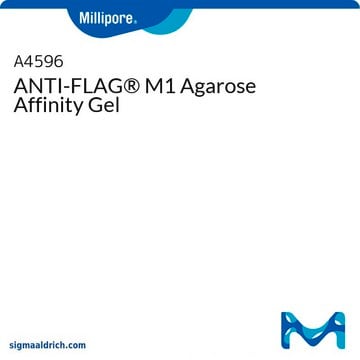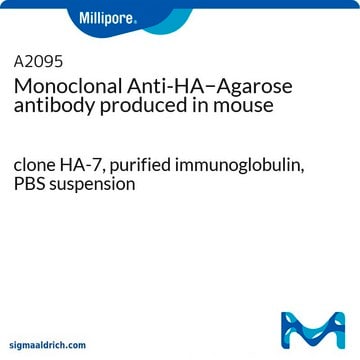11815024001
Roche
Anti-Protein C Affinity Matrix
from mouse IgG1κ
Sinônimo(s):
affinity matrix, anti-protein c
Faça loginpara ver os preços organizacionais e de contrato
About This Item
Código UNSPSC:
12352203
Produtos recomendados
fonte biológica
mouse
Nível de qualidade
conjugado
agarose conjugate
forma do anticorpo
purified immunoglobulin
clone
HPC4, monoclonal
forma
slurry
embalagem
pkg of 1 mL (settled resin volume)
fabricante/nome comercial
Roche
Isotipo
IgG1, kappa
capacidade
2-10 nmol/mL binding capacity
temperatura de armazenamento
2-8°C
Descrição geral
Protein C is a Vitamin K-dependent plasma zymogen that is activated by proteolytic cleavage of the thrombin-thrombomodulin complex to form an anticoagulant enzyme. Anti-Protein C mouse monoclonal antibody (clone HPC4) binds specifically to an epitope sequence spanning the thrombin cleavage site of protein C and is immobilized. Anti-Protein C recognizes the 12-amino acid sequence (EDQVDPRLIDGK), which encodes residues 6 through 17 of the heavy chain of Protein C. The formation of the Anti-Protein C/protein C epitope complex is dependent on the presence of calcium ions. In the presence of Ca2+, the antibody binds with high affinity and specificity to this sequence in native human Protein C or in proteins tagged with this epitope. This efficient binding within the recombinant fusion protein occurs regardless of the site of incorporation of the epitope tag (i.e., N terminus, C terminus, or within the reading frame). This unique antibody is especially well suited for purification of recombinant fusion proteins tagged with the protein C epitope.
Monoclonal mouse antibody Anti-Protein C (clone HPC4) is covalently coupled to agarose beads. In the coupling reaction 4mg of antibody is reacted per 1ml of beads.
- Insertion of the protein C tag does not introduce a new metal-ion binding site. The antibody contains the Ca2+ binding site.
- Protein C tag can be integrated either at the N-terminus, C-terminus or internally without any change in antibody specificity.
- Rapid immunoaffinity purification under non-denaturing conditions using economical calcium chelating agent (e.g., EDTA) or alternatively a specific protein C-tag peptide.
Monoclonal mouse antibody Anti-Protein C (clone HPC4) is covalently coupled to agarose beads. In the coupling reaction 4mg of antibody is reacted per 1ml of beads.
Especificidade
Anti-Protein C recognizes the 12-amino acid sequence EDQVDPRLIDGK, which encodes residues 6 to 17 of the heavy chain of protein C. In the presence of Ca2, the antibody binds with high affinity and specificity to this sequence in native human protein C or in proteins tagged with this epitope. Efficient binding within the recombinant fusion protein occurs regardless of epitope position (N-terminal, C-terminal, or internal).
Aplicação
Anti-Protein C Affinity Matrix is used for:
Following immunoprecipitation or purification, the tagged protein of interest may be analyzed by:
- Immunoprecipitation of Protein C-tagged proteins from mammalian, bacterial, and yeast cell extracts
- Affinity column purification of Protein C-tagged proteins from crude protein extracts
Following immunoprecipitation or purification, the tagged protein of interest may be analyzed by:
- Western blotting using the Anti-Protein C antibody
- Silver staining (or similar protein stain)
Características e benefícios
- use gentle elution conditions using calcium-chelating agents like EDTA.
- highly specific to EDQVDPRLIDGK, derived from protein C.
- binding of Anti-Protein C to protein C-epitop is dependent on the presence of calcium ions.
- suitable for purification of proteins containing protein C as N-terminal, C-terminal or internal fusion.
- applicable with crued cell extracts from mammalian, bacterial, and yeast expression systems.
Contents
1. The antibody is covalently coupled to agarose beads and supplied as a 2ml slurry containing 1ml beads and 1ml buffer.
2. 4mg of antibody is reacted per ml of beads in the coupling reaction.
3. A plastic column with top and bottom caps is included.
Embalagem
1 kit containing settled resin and column
Qualidade
Each lot of Anti-Protein C Affinity Matrix is tested for its ability to purify a Protein C-tagged protein expressed in transformed bacteria from crude bacterial extract. The antibody affinity column is used in combination with western blot and/or silver stain analysis.
forma física
1 ml settled resin of Anti-Protein C Affinity Matrix in 20 mM Tris, 0.1 M NaCl, 1 mM CaCl2, and 0.09% sodium azide (w/v); 2 ml suspension equals to 1 ml bed volume. One plastic column with top and bottom caps is included
Nota de análise
KD = 10–9 M Binding Capacity is 2 to 10 nmol/ml affinity matrix. Yield of 10.5 nmol purified protein/ml affinity matrix was determined using a whole-cell bacterial extract containing protein C-tagged β-galactosidase.
Outras notas
For life science research only. Not for use in diagnostic procedures.
Código de classe de armazenamento
12 - Non Combustible Liquids
Classe de risco de água (WGK)
WGK 1
Ponto de fulgor (°F)
does not flash
Ponto de fulgor (°C)
does not flash
Certificados de análise (COA)
Busque Certificados de análise (COA) digitando o Número do Lote do produto. Os números de lote e remessa podem ser encontrados no rótulo de um produto após a palavra “Lot” ou “Batch”.
Já possui este produto?
Encontre a documentação dos produtos que você adquiriu recentemente na biblioteca de documentos.
Jing Huang et al.
Journal of molecular and cellular cardiology, 66, 157-164 (2013-11-26)
Despite advances in the treatment of acute tissue ischemia significant challenges remain in effective cytoprotection from ischemic cell death. It has been documented that injected stem cells, such as mesenchymal stem cells (MSCs), can confer protection to ischemic tissue through
Mary Anne T Rubio et al.
Nature, 542(7642), 494-497 (2017-02-24)
Nucleic acids undergo naturally occurring chemical modifications. Over 100 different modifications have been described and every position in the purine and pyrimidine bases can be modified; often the sugar is also modified. Despite recent progress, the mechanism for the biosynthesis
Florian Bundis et al.
Cellular physiology and biochemistry : international journal of experimental cellular physiology, biochemistry, and pharmacology, 17(1-2), 1-12 (2006-03-18)
The weak inward rectifier potassium channel ROMK is important for water and salt reabsorption in the kidney. Here we identified Golgin-160 as a novel interacting partner of the ROMK channel. By using yeast two-hybrid assays and co-immunoprecipitations from transfected cells
Gabriela Schumann Burkard et al.
Molecular microbiology, 88(4), 827-840 (2013-04-27)
Different life-cycle stages of Trypanosoma brucei are characterized by stage-specific glycoprotein coats. GPEET procyclin, the major surface protein of early procyclic (insect midgut) forms, is transcribed in the nucleolus by RNA polymerase I as part of a polycistronic precursor that
Daniela Luz Ambrósio et al.
Eukaryotic cell, 8(7), 990-1000 (2009-05-12)
In trypanosomatid parasites, spliced leader (SL) trans splicing is an essential nuclear mRNA maturation step which caps mRNAs posttranscriptionally and, in conjunction with polyadenylation, resolves individual mRNAs from polycistronic precursors. While all trypanosomatid mRNAs are trans spliced, intron removal by
Nossa equipe de cientistas tem experiência em todas as áreas de pesquisa, incluindo Life Sciences, ciência de materiais, síntese química, cromatografia, química analítica e muitas outras.
Entre em contato com a assistência técnica








